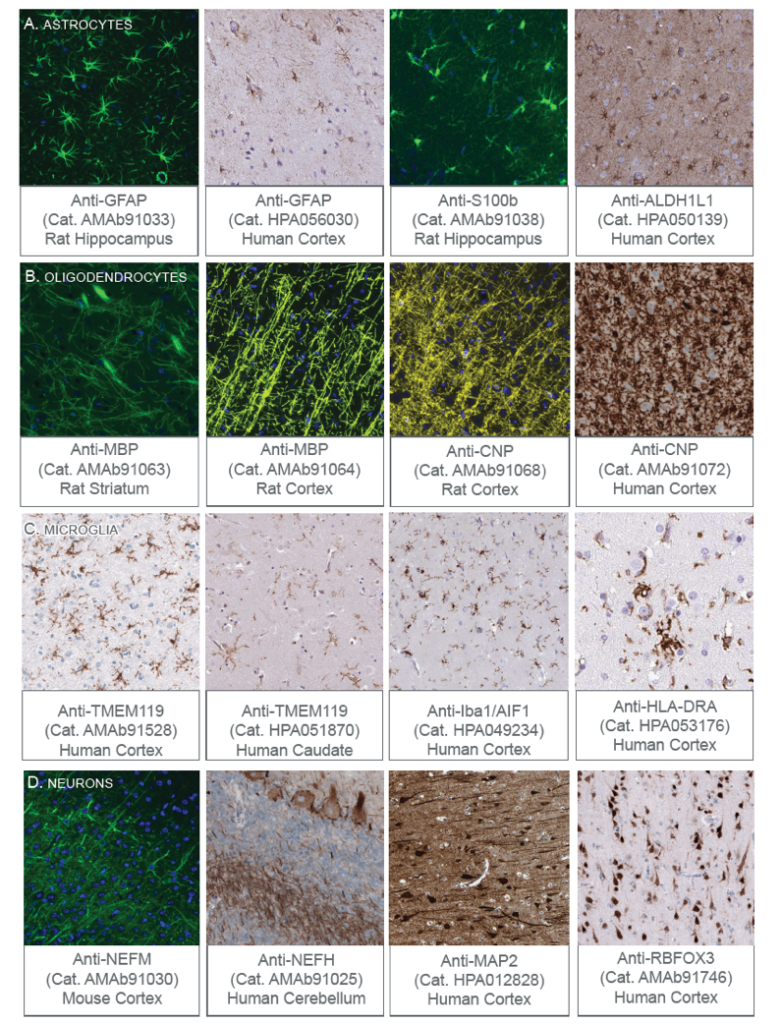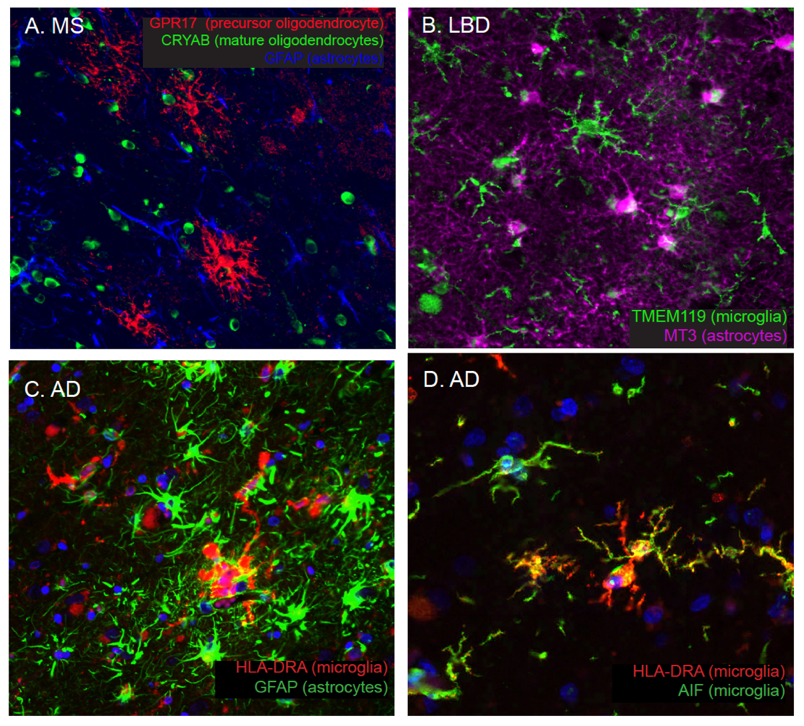Unlocking cancer insights with antibodies targeting CD markers
Explore how CD markers advance cancer research, providing critical insights into cell populations and disease prognosis.
Mapping the brain proteome in health and disease is crucial for understanding how different cell types interact, helping to detect abnormalities linked to neurological disorders and guiding the development of better treatments.
The human brain is an incredibly complex organ, and despite significant advances in neuroscience, much of its intricate functioning remains elusive. To effectively address neurological diseases, it is essential to first understand the brain’s molecular landscape in its normal state. A critical step in this process is identifying the various brain cell types and revealing how they communicate and interact under healthy conditions. Establishing this baseline of normal cellular activity is key to detecting abnormalities linked to neurological disorders and is vital for developing more targeted and effective treatments.
The brain contains several cell types, including neurons, astrocytes, oligodendrocytes, and microglia, all of which vary in number across different brain regions. Each of these brain cell types is defined by specific protein markers, which are essential for their distinct roles within neural tissue. Mapping these cell-type-specific markers allows for the precise identification and characterization of each cell type and provides a foundation for studying their involvement in neurological diseases.
By establishing a baseline of normal protein expression and cellular function in the brain, researchers can more easily detect the deviations that signal the onset of various neurological disorders.

Several protein markers become dysregulated in various neurological disorders, serving as indicators of pathological processes. Below is an overview of key markers associated with neuroinflammation, neurodegeneration, multiple sclerosis, and gliomas.
GFAP: Astrocyte marker, upregulated during inflammation.
IBA1: Marker for activated microglia, indicating microglial activation.
CD68: Found on activated microglia and macrophages.
TNF-α: Pro-inflammatory cytokine elevated in neuroinflammatory conditions.
IL-1β: Pro-inflammatory cytokine involved in the neuroinflammatory response.
MHC Class II: Expressed on microglia and macrophages, associated with immune response activation.
β-Amyloid: Central protein in plaque formation in AD brains.
Tau Protein: Hyperphosphorylated tau forms neurofibrillary tangles, a hallmark of AD.
APP (Amyloid Precursor Protein): Precursor molecule for β-amyloid; altered processing is linked to AD.
BACE1: Enzyme involved in β-amyloid production.
PSEN1: Part of the γ-secretase complex involved in APP processing.
APOE4: Genetic risk factor for AD, linked to amyloid deposition.
α-Synuclein: Forms Lewy bodies, characteristic of PD.
Parkin: Involved in the ubiquitin-proteasome pathway; mutations are linked to familial PD.
DJ-1: Associated with oxidative stress; mutations are linked to PD.
LRRK2: Mutations are a common cause of familial PD.
PINK1: Involved in mitochondrial function, linked to PD.
TH (Tyrosine Hydroxylase): Rate-limiting enzyme in dopamine synthesis; used to identify dopaminergic neurons.
MBP (Myelin Basic Protein): Key protein in the myelin sheath, targeted in MS.
MOG (Myelin Oligodendrocyte Glycoprotein): Targeted by the immune system in MS.
GFAP: Indicates astrocytic response in MS.
CD3: T-cell marker involved in MS pathology.
IL-17: Cytokine produced by Th17 cells, involved in MS progression.
GFAP: Astrocyte lineage marker, used to identify astrocytomas.
IDH1: Mutations common in lower-grade gliomas and secondary glioblastomas.
MGMT: Promoter methylation status predictive of response to alkylating agents in glioblastoma.
EGFR: Often amplified or mutated in glioblastoma.
p53: Tumor suppressor, frequently mutated in gliomas.
Ki-67: Proliferation marker used to assess tumor growth rate.

Demyelination, the pathological process affecting myelinated nerve fibers and oligodendrocytes, is the primary pathological event in multiple sclerosis. The image shows the multiplexed immunofluorescence staining of rat brain (EAE, experimental autoimmune encephalomyelitis model of multiple sclerosis) using Anti-CRYAB antibody (AMAb91661, green) as marker for mature oligodendrocytes, Anti-GPR17 antibody (HPA029766, red) as marker for oligodendrocyte precursor cells, and anti-GFAP antibody (AMAb91033, blue) as marker for astrocytes.
Lewy body dementia (LBD) is one of the most common neurodegenerative illnesses. The image shows a multiplexed immunofluorescence staining of astrocytes and microglia in the cerebral cortex of Lewy body dementia patient, using Anti-MT3 polyclonal antibody (HPA004011, magenta) as astrocyte marker and Anti-TMEM119 monoclonal antibody (AMAb91528, green) as microglia marker.
The interaction between astrocytes and reactive microglia is critical in the development of neuroinflammation and neurodegeneration. The image shows multiplexed immunofluorescence staining of human cerebral cortex from the Alzheimer’s disease patient using Anti-GFAP antibody (AMAb91033, green) as astrocyte marker and Anti-HLA-DRA antibody (AMAb91674, red) as microglia marker. Nuclei counterstained by DAPI, in blue.
Multiplexed immunofluorescence staining of human cerebral cortex from the Alzheimer’s disease patient using Anti-AIF antibody (HPA049234, green) and Anti-HLA-DRA antibody (AMAb91647, red) as different types of microglia markers. Nuclei are counterstained by DAPI, in blue.
Mapping the brain proteome in both health and disease is key to advancing our understanding of the brain’s molecular architecture and its deviations in pathological states.
By leveraging primary antibodies and cell-type-specific markers, we can establish a foundational understanding of normal brain function, enabling the detection of early signs of neurological disorders. This approach is critical for developing new diagnostic tools and therapeutic strategies for diseases such as Alzheimer’s, Parkinson’s, multiple sclerosis, and gliomas, ultimately leading to more effective and targeted treatments.
| MARKERS FOR ASTROCYTES | MARKERS FOR GLIOMAS |
|---|---|
| anti-ADGRV1 (HPA067503) | anti-EZH2 (AMAb91752) |
| anti-AQP9 (HPA074762) | anti-FGFR1 (HPA056402) |
| anti-CD44 (HPA005785) | anti-FOXO3 (AMAb91872) |
| anti-EZR (AMAb90976) | anti-GLI1 (AMAb91772) |
| anti-FGF2 (HPA065502) | anti-GFAP (AMAb91033) |
| anti-FYN (HPA023887) | anti-ID1 (AMAb91757) |
| anti-GFAP (AMAb91033) | anti-IL33 (AMAb91858) |
| anti-GLUL (AMAb91101) | anti-NF1 (AMAb91741) |
| anti-GPC5 (HPA040152) | anti-POSTN (AMAb91764) |
| anti-HPSE2 (HPA044603) | anti-PTEN (AMAb91735) |
| anti-PTPRZ1 (HPA015103) | anti-RUNX2 (HPA022040) |
| anti-S100B (AMAb91038) | anti-SLC6A6 (HPA016488) |
| anti-SLC1A2 (HPA009172) | anti-ZEB2 (AMAb91862) |
| anti-SLC1A3 (HPA037467) |
| MARKERS FOR MICROGLIA | MARKERS FOR NEURONS |
|---|---|
| anti-AIF1 (AMAb91671) | anti-MAP2 (HPA008273) |
| anti-CD163 (AMAb91646) | anti-NeuN (HPA070789) |
| anti-CUX1 (AMAb91352) | anti-NEFM (AMAb91027) |
| anti-HLA-DRA (AMAb91674) | anti-NSE (AMAb90556) |
| anti-ITGAM (AMAb90911) | anti-SYP (HPA002858) |
| anti-PTPRC (AMAb90518) | anti-TUBB3 (AMAb91394) |
| anti-SPP1 (HPA027541) |
| MARKERS FOR NEURODEGENERATION | MARKERS FOR OLIGODENDROCYTES | MARKERS FOR NEUROINFLAMMATION |
|---|---|---|
| anti-APOE (HPA065539) | anti-ALCAM (HPA010926) | anti-AGER (AMAb91635) |
| anti-APP (HPA001462) | anti-CNP (AMAb91069) | anti-GAP43 (AMAb91664) |
| anti-CDK5 (HPA064535) | anti-COL1A2 (HPA059738)* | anti-GZMB (AMAb91650) |
| anti-CLU (HPA000572) | anti-COL9A1 (HPA074749) | anti-IL17RA (AMAb91617) |
| anti-CREB1 (HPA019150) | anti-CRYAB (AMAb91661) | anti-ITGA4 (HPA074961) |
| anti-GAPDH (AMAb91153) | anti-CST3 (HPA013143)* | anti-MBP (AMAb91063) |
| anti-GRN (AMAb91385) | anti-GRIK2 (HPA014623) | anti-MS4A1 (HPA014391) |
| anti-GSK3B (HPA028017) | anti-MBP (AMAb91063) | anti-P2RX4 (HPA039494) |
| anti-HDAC6 (HPA026321) | anti-OPALIN (AMAb91685) | anti-P2RX7 (AMAb91714) |
| anti-MAPT (HPA069524) | anti-PDGFRA (HPA004947) | anti-PLP1 (AMAb91639) |
| anti-NOS1 (HPA069509) | anti-PLP1 (HPA004128) | anti-S100A8 (HPA024372) |
| anti-NRGN (HPA038171) | anti-SOX6 (AMAb91383) | anti-S100A9 (AMAb91690) |
| anti-NTRK1 (HPA035799) | anti-STK32A (HPA040236) | anti-SORT1 (AMAb91428) |
| anti-PARK2 (HPA036012) | anti-TLL1 (HPA060767) | anti-TCF7L2 (AMAb91716) |
| anti-PSEN1 (HPA030760) | anti-VCAN (HPA004726) | anti-TLR2 (AMAb91631) |
| anti-SNCA (HPA005459) | anti-TREM1 (AMAb91459) | |
| anti-TSPO (AMAb91854) |
We gladly support you by keeping you updated on our latest products and the developments around our services.